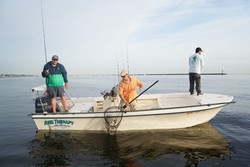Megan Phifer-Rixey, Ph.D., an evolutionary biologist and Assistant Professor in the Biology department, presented as part of the Evolution Symposium at the 2019 National Association of Biology Teachers (NABT) Conference, on Nov. 14-17 in Chicago.
Phifer-Rixey presented her research, including a collaboration with John Tiedemann, Assistant Dean of the School of Science, to an assembly of biology teachers. Her talk focused on the use of genetic markers to identify the source populations of the migratory Striped Bass, from both off-shore and near-shore areas.
The project used DNA analysis to identify the stock-specific origin of Striped Bass in Ocean County, to determine the contribution of individual stocks.
Tiedemann started the project and worked with the Berkley Stripers Club, a local fishing club, that is focused on fishing along the beaches of Ocean County, which inspired his decision to research where the Striped Bass that are harvested in the fall originate.
The club supported the research and contributed fin clips. Tiedemann explained that “The fin clips are brought back to the lab to extract the DNA. We can analyze the DNA isolated from the fish to match it to a library of DNA fingerprints that identify the spawning grounds.”
Phifer-Rixey said, “We started doing the work in my lab in 2018 through the Summer Research Program. I thought this was a good fit because students were able to learn how to do molecular genetics.”
The project allowed for collaborative research within the Biology department. Tiedemann said, “It was a cool project because my students in the Marine and Environmental Policy Program are interested in the fisheries side of it, and Phifer-Rixey’s students are learning all these laboratory techniques to do DNA analysis.”
My students worked with the club to get the fin clips and delivered them to [Phifer-Rixey and her students] to do the analysis,” he continued.
Phifer-Rixey explained that the most powerful aspect of this research is the use of genetic information to better inform management. “When the Federal Government makes decisions about catch limits and size limits, research like this helps [policymakers] determine what strategies are going to be.”
“The key with a fishery like this is because it involves so many locations there needs to be engagement across the region,” Phifer-Rixey said.
Spawning grounds are all over the place with the most common being the Chesapeake Bay, Delaware River and Hudson River.
Through the National Science Foundation (NSF), which has a program where they pay a stipend for high school teachers to come into research labs, with the goal of bringing research skills back to their students, two high school teachers were able to work with Phifer-Rixey in the summers of 2018 and 2019.
Phifer-Rixey’s research is part of Tiedemann’s broader research agenda. His program, “Stripers for the Future,” a research and education campaign, is designed to educate Striped Bass anglers about biology, ecology and conservation.
PHOTO COURTESY of Monmouth University




